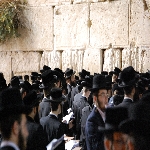NEXT YEAR IN JERUSALEM

You want to experience the beating heart of the Jewish people? You want to gain a deep understanding of this city’s importance to Jews throughout its history? Why did Jews return here time and again after they were forcibly removed?
We will start this eight-hour tour by learning about the nearly 4000-year old history of this amazing city. We will discuss why King David decided to establish his capital here and we will analyze the exact meaning of the Jewish Temple that stood on Mount Moriah. We will continue by exploring some proof of Jewish life in ancient Jerusalem, and we will look at the recent history of the Jewish Quarter. At the end of the tour, we will have a clear understanding of why Jews end each Passover-Seder by proclaiming Next Year in Jerusalem.
SITES INCLUDED IN THIS TOUR
Jaffa Gate
One of the eight gates that lead into the Old City of Jerusalem. Built by Ottoman Sultan Suleiman the Great in the 16th century, its doors were closed every day by sunset until 1860. In 1898, part of the city wall next to Jaffa Gate was torn down in order to permit German Kaiser Wilhelm II to enter the city with his entourage.
Tower of David
No other place represents the colorful history of Jerusalem like the Tower of David. On this site, located right next to the Jaffa Gate, every ruler of Jerusalem had always built his stronghold in order to protect the entrance to the city. This is the reason why archaeologists found layers upon layers of history buried underneath today's Tower of David compound. The site itself features a museum telling the adventurous history of the Holy City of Jerusalem. A visit to the Tower of David is therefore the perfect place to start learning about the history of this amazing city.
Market Rooftop Lookout Point
Located at the junction of all four Quarters of the Old City, this observation point allows for an unobstructed view over the entire city, as well as for a panoramic view of the Mount of Olives, beyond which lies the Judean Desert. Visiting these rooftops will make you regain your orientation within the Old City, after having visited the maze of alleyways and markets down below.
Hurva Synagogue
The word "Hurva" means "ruin" in Hebrew. The Hurva Synagogue had been destroyed various times throughout its history - but after each destruction the inhabitants of the Jewish Quarter decided to rebuild this house of prayer. Today the square in front of the Hurva Synagogue is the center of the Jewish Quarter and the synagogue itself is seen as a symbol for the resilience of the inhabitants of the Jewish Quarter.
Roman Cardo
The Old City of Jerusalem was under Jordanian control between 1948 and 1967. During these 19 years, the Jewish Quarter was almost entirely destroyed by the Jordanians, which meant that everything had to be rebuilt after the Six Day War of 1967. Before the rebuilding, archaeologists were allowed to perform archaeological digs in the Jewish Quarter, resulting in some of the most amazing discoveries ever made in the Old City. One such discovery was the Roman Cardo, which was the main North-South axis that stretched through the city that was then called Aelia Capitolina.
Broad Wall
The Broad Wall is the excavated part of an 8th century BC eight meter high wall, located in the Jewish Quarter of Jerusalem's Old City. Archaeologically, this 1970's excavation is highly significant, as it proves a story that is mentioned in the Torah, the Jewish Bible: there it is described how King Hezekiah of Judah hastily built a defensive wall in preparation of the advancing army of Sennacherib, king of Assyria.
Gal-Ed Memorial
This former mass-grave is today a memorial to those Jewish fighters who died in the defense of the Old City's Jewish Quarter during the Independence War of 1948. Due to the circumstances of the war, the fallen Jewish fighters could not be buried outside the city walls, as prescribed by Jewish burial custom. After the Israeli Army conquered the Old City of Jerusalem in 1967, the remains of these fighters were reinterred in a grave site on the Mount of Olives.
Batei Mahse
Batei Mahse (Hebrew for Shelter Houses) was an apartment-complex built in the late 19th century with the financial aid of such Jewish philanthropists as Baron Rothschild. Before this time, the Jews of Jerusalem had to live in squalid conditions due to the fact that they were often not allowed by the Ottoman rulers to own apartments or even hold a job. During the 1948 War of Independence, these apartments provided shelter for the residents of the beleaguered Jewish Quarter and it was from here that the Jewish population had been evacuated after became clear that the Jewish forces cannot hold the Jewish Quarter.
The Burnt House
The Burnt House - also know as the Katros House - is an underground excavation site featuring remains of a Jewish house dating to the Second Temple Period. It is believed that this house had been set on fire by the Roman soldiers who destroyed the city of Jerusalem in the year 70 AD. Inside the Burnt House we will find various remains of the period, allowing for a unique glimpse into the day-to-day life of 2,000 years ago.
Aish HaTorah Center
Aish HaTorah is a Jewish Orthodox organization, which maintains a beautiful center in the heart of the Jewish Quarter of the Old City. A visit to the Old City is never complete without a visit to the rooftop terrace of the Aish HaTorah center, from where you can enjoy a magnificent view over the Western Wall and the Temple Mount, as well as over the Mount of Olives.
NEXT YEAR IN JERUSALEM
A Jewish Heritage Tour of Jerusalem
1
25
Price DOES NOT include transportation, lodging, food, drinks or entrance fees


